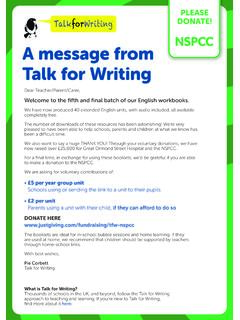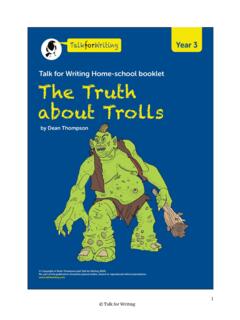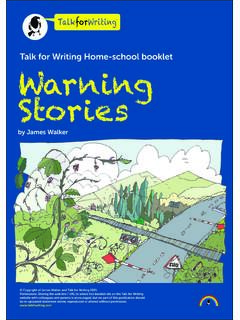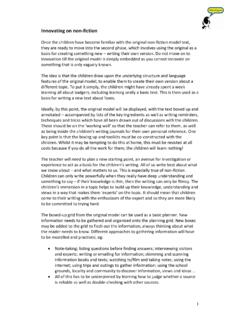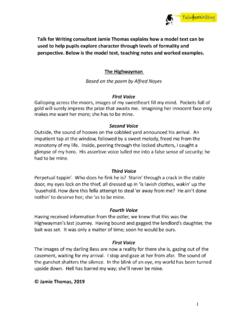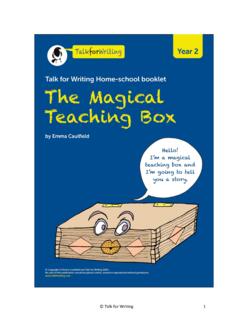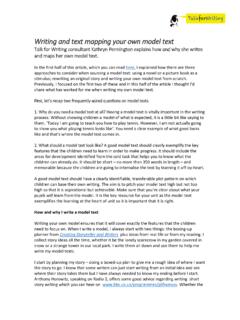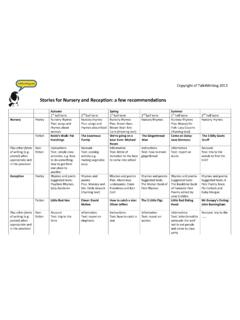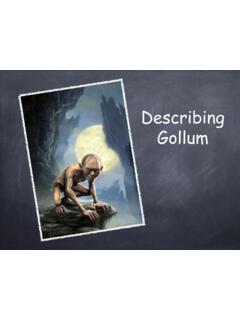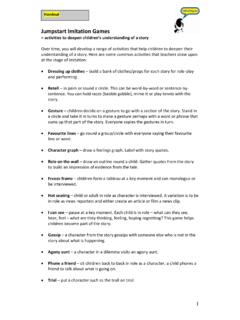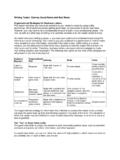Transcription of A message from Talk for Writing
1 A message from Talk for WritingPLEASEDONATE!Please donate to Great Ormond Street Hospital Children s Charity if you use this Teacher/Parent/Carer, Welcome to the third batch of home-school unit booklets!The first two batches of units have reached hundreds of thousands of children and the positive feedback has been overwhelming. The units are intended to be used with online support by class teachers and by parents at home. They are produced by unpaid volunteers who are giving their time to help teachers, families and children while the schools are closed and we want to use the units to help an extremely good are asking for voluntary contributions to Great Ormond Street Hospital of: 5 per year group unit Schools using or sending the link to a unit to their pupils 2 per unit Parents using a unit with their child, if they can afford to do soEvery single penny raised will go directly to Great Ormond Street Hospital.
2 Due to Covid-19, the hospital has increased its intensive care capacity to make sure they have room for some of the UK s most seriously ill children. They need support now more than ever to give these children a better HERE hope you enjoy using the unit. Thank you for your support. With best wishes, Pie Corbett Talk for WritingWhat is Talk for Writing ? Thousands of schools in the UK, and beyond, follow the Talk for Writing approach to teaching and learning. Find more about it here. 1 Talk for Writing 2 Talk for Writing Introduction Little Red Riding Hood is a fairy tale about a young girl and a Big Bad Wolf. Although there have been many adaptations of this childhood classic, the most well-renowned being that of the brothers Grimm, the earliest known printed version was entitled Le Petit Chaperon Rouge, in 1697, by Charles Perrault. I have always loved taking a story I know really well and considering how I could manipulate it to change its meaning or impact on the reader.
3 The levels of sophistication are endless. You can change the order of events, retelling from a different character s perspective, swap the protagonist, alter the genre or the text type .. the list goes on. When I first met Pie, I remember him saying, Imagination is the manipulation of what you know. This is at the heart of what I think storytelling is all about being playful with the stories and plots that we know and love. Our focus throughout this unit is to consider how we can take a story designed for a younger audience and adapt it for older readers. Preparing to write As an author, it is highly recommended that you keep a jotter or notebook, otherwise known as a magpie book, by your side to capture any ideas you may have as the unit unfolds. This book can be used to make notes, jot down ideas and draft initial thoughts. Red is a story that is rich in imagery, designed to evoke emotion in the reader.
4 As we explore the story, we will pause and consider how it has been created. Noting down these tools, testing them out for yourself and trying to identify them in other fiction will greatly enhance your skills as a writer. 3 Talk for Writing Activity 1: Tuning in to the genre Before we read the story, I want you to tune in to the genre we are exploring. Watch this wonderful short animation, entitled Chaperon Rouge: In your jotter, write down your initial responses to the animation. You may like to reflect on some of the following elements: o what you enjoyed or disliked o what surprised, puzzled or intrigued you o what unanswered questions you still have o how the animation made you feel o what other stories it may have reminded you of o what themes lie at the heart of the story Now, let s read the story, Red. You can listen to this being read aloud here: Red Don t stray from the path!
5 Skipping through the forest, Red, so named because of her favourite cloak, recognised the familiar smell of the lush flowers that she passed every week. The stone-laid path meandered through tall, majestic trees, forming a canopy of serenity. Red stopped to pick a handful of the gently nodding daffodils that flanked the path to her Grandmother s house. As she crouched, a gentle breeze filled her nostrils with a waft of unfamiliar perfume. What is that? Red pondered. Staring inquisitively towards the undergrowth, her mother s words echoed meaninglessly, yet continuously, around in her head: Don t stray from the path! But why should she always listen to her 4 Talk for Writing mother? Surely one look couldn t hurt, could it? Overcome with curiosity, Red stepped from the path. Parting the emerald leaves, Red s eyes sparkled with excitement. In front of her, handfuls of pink confetti drifted down from the boughs of majestic cherry trees; joyous birdsong twittered above her, harmonising the melodic humming of the bees.
6 She could feel her heart racing in anticipation and wondered what other treasures lay beyond the path. In the distance, a lake of dancing primroses enticed her further in; her mother s words were now lost. Deeper and deeper Red walked, transfixed by the exquisite offerings of the forest. Deeper and deeper she walked, unaware of the world changing around her. Deeper and deeper she walked, until nothing was recognisable. The trees, once a canopy of serenity, now formed foreboding tunnels, suppressing all life in their thorny grasp. The forest floor, once a blazing carpet of confetti, was now a complex maze of brambles and thorns, tearing at Red s vulnerable ankles. The birdsong had stopped; the silence was deafening. All of a sudden, Red felt like something or someone was watching her; she sensed its presence. An uncontrollable shiver ran down her spine as she realised that she was not alone. What was it?
7 Panicking, she spun around, hoping to find the path but it was too late. Red s breathing quickened; her heart hammered against her chest as terror bubbled in her throat. Panic immediately seized her in a spiral of darkness as a sinister shadow grew through the trees. Two malevolent eyes .. the stench of rotten breath .. a spine-chilling howl .. Don t stray from the path! How foolish she had been! Jamie Thomas 5 Talk for Writing Activity 2: Initial Response Now you have read the story, take a moment to reflect on how it made you feel as a reader. In your jotter, write down your initial responses to the story. You may like to reflect on some of the following elements: o what you enjoyed or disliked o what surprised, puzzled or intrigued you o how the story made you feel o what other stories it may have reminded you of o what themes lie at the heart of the story o what morals there are to be learned How does the story compare/contrast to the animation?
8 Make a list of similarities and differences. Which do you feel is more effective and why? Activity 3: Vocabulary Let s revisit some of the vocabulary and turns of phrase within the text. Below is a never heard the word grid. Have a look at the words and phrases I have chosen and assess your understanding by ticking and annotating the relevant box. If you know the word, please jot down a definition in your own words. Word or phrase Never heard of it Heard of it but not sure of meaning Heard of it and here is a definition/explanation of what it means canopy serenity pondered inquisitively anticipation 6 Talk for Writing primroses enticed transfixed foreboding suppressing all life vulnerable malevolent If there are any words that you do not fully understand, look them up and add them, along with their definitions, into your jotter or magpie book. Challenge yourself to try to use these words in your own story to expand your own vocabulary knowledge.
9 Activity 3: Establishing the theme At the heart of any story lies an underlying theme. Sometimes there are many, entwined through complex plots and backstories, but once you get to the heart of the story, there is always an over-arching theme. In Red, the theme being explored is the human characteristic naivety. To be described as na ve means you demonstrate a lack of experience or understanding. Furthermore, naivety has developed into an almost derogatory term, inferring that you are incompetent and inadequate. A na ve person will often act on impulse, going with their gut feeling, rather than calculating the most sensible option. Consider the theme of naivety. How many other stories that you know or have read explore this character trait? What can we learn from these characters? Why do you think authors choose to explore this in stories designed for young children? 7 Talk for Writing Now consider a few books that you love.
10 What are the underlying themes of each story? For example, the underlying themes in Romeo and Juliet are hatred and love. The underlying theme in Beowulf is heroism. As a reader, is there a theme that you enjoy reading about? Consider how this may influence you as a writer. Share your thoughts with someone and discuss how your interests differ or are similar. Activity 4: Comprehension We are now going to revisit the story and try to dig a little deeper in terms of our understanding. Below are four reading strategies that I would like you to explore. For each, you will need to go back and find evidence in the text that supports your opinion. Try to form a calculated, cohesive response. For some questions, it may help if you follow this simple pattern: 1. Answer the question with a statement. 2. Back up your statement with evidence found in the text. 3. Explain how the evidence supports your statement.
